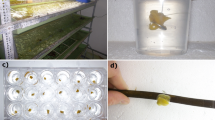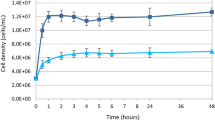Abstract:
Among Metazoa, sponges (phylum Porifera) are the richest source for different bioactive compounds. The availability of the raw material is, however, restricted. To obtain enough of the bioactive compounds for application in human therapy, sponges have to be cultured in in vitro systems. One technique for the establishment of a long-term cell culture from sponges has recently been elaborated. Here, we present a procedure to cultivate tissue samples from sponges in an open system. The species Geodia cydonium, which produces bioactive compounds, has been selected. Tissue samples of approximately 10 g were attached to the bottoms of cultivation trays. After 2 to 3 days, the tissue samples formed a robust contact with the metal support. Subsequently, sets of trays, called tray batteries, either remained in huge aquaria at the Center for Marine Research or were transferred to the vicinity of a fish and mussel farm. The growth rates of the samples remained unchanged within the first month; however, after 3 and 6 months, they increased to 147% and 189%, respectively. In parallel, extracts were prepared from the tissue samples and tested for cytotoxicity in a mouse lymphoma cell assay system. Extracts from cultured tissue initially had a low inhibitory potency; however, after cultivation for 3 or 6 months, values comparable to those of extracts from sponges taken from the biotope were found. In addition, a molecular marker was applied to document the response (health state) of the tissue and the identity of the material in culture. The CD63 molecule was chosen because the expression of this molecule in mammalian systems changes with the age of the animals. The corresponding complementary DNA was isolated from Geodia cydonium. With this probe, the level of expression in cultured tissue samples decreased immediately after starting cultivation; after a cultivation period of 6 months, however, values were similar to those found in controls. These data show that sponge species that produce bioactive compounds can be cultivated in open systems, in which they retain their potency to produce bioactive compounds as well as their health state.
Similar content being viewed by others
Author information
Authors and Affiliations
Additional information
Received September 16, 1998; accepted June 18, 1999
Rights and permissions
About this article
Cite this article
Müller, W., Wimmer, W., Schatton, W. et al. Initiation of an Aquaculture of Sponges for the Sustainable Production of Bioactive Metabolites in Open Systems: Example, Geodia cydonium . Mar. Biotechnol. 1, 569–579 (1999). https://doi.org/10.1007/PL00011812
Issue Date:
DOI: https://doi.org/10.1007/PL00011812




